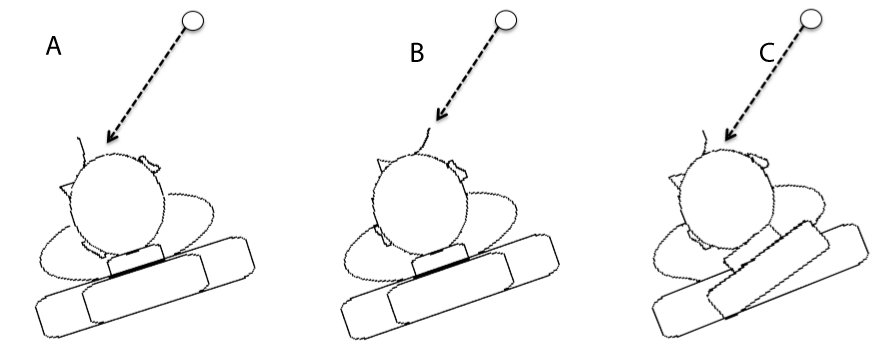
A. Patient with no neck arthritis is lying supine on the operative table that is tilted 20-30 degrees in the sagittal plane. The facelift skin flaps of the right cheek are elevated and the surgeon’s line of vision is able to visualize the underlying skin and Superficial Musculoaponeurotic System (SMAS) layer. The prolonged rotation of the neck at this angle of 45 degrees may result in early patient discomfort in an awake patient and/or post-operative neck pain in a sedated patient.
B. The typical facelift patient undergoing facelift surgery with stiff neck secondary to undiagnosed cervical spondylosis. As compared to the flat horizontal position, a 20-30 degrees of rotation of the operative table will allow the surgeon to have improved visualization of the surgical field despite the inadequate ability of the patient to rotate his/her neck. The underlying surface of the skin flap is still difficult to visualize thus forcing the surgeon to arch his/ her neck and back to better attain a clear line of vision. Prolonged arching, bending, and twisting of the surgeon’s neck may lead to neck pains resulting in cervical spondylosis and muscle spasm. The operative table should not be rotated further than 20-30 degrees in the sagittal plane as to prevent the patient from sliding off despite the mandatory seatbelt security.
C. The surgeon possesses superior visualization of the whole operative field including the SMAS and underlying skin flap surface in the stiff neck patient secondary to the differential rotation of the neck piece of the operative table. The patient is secure from sliding off the table with the seatbelt and the fact that the body of the patient is not rotated more than 20-30 degrees in the sagittal plane. The surgeon can continue the operation with a comfortable upright back and neck with superior visualization of the surgical field.